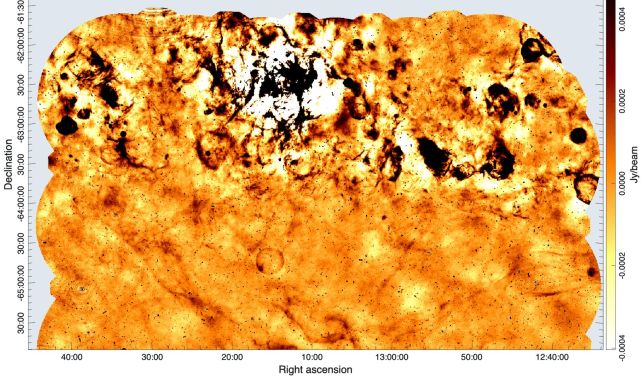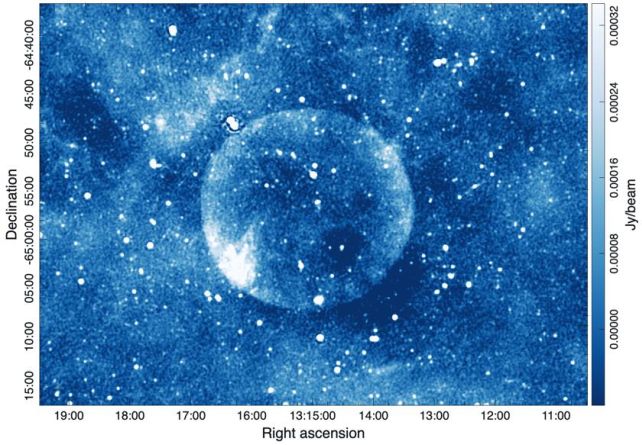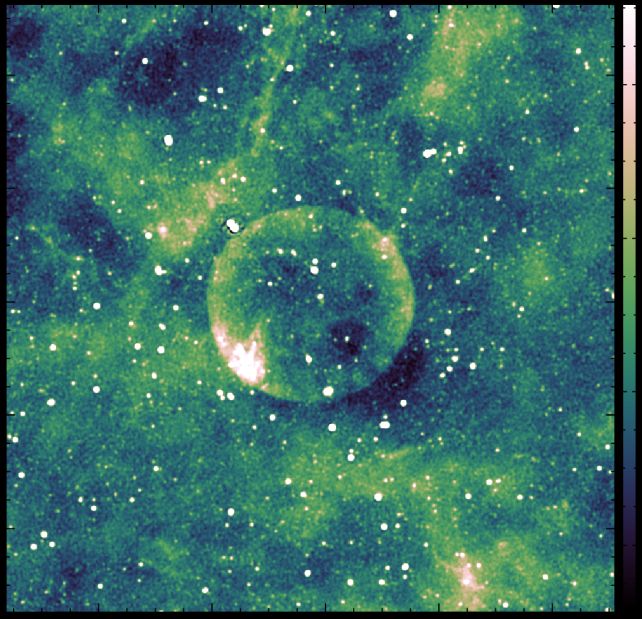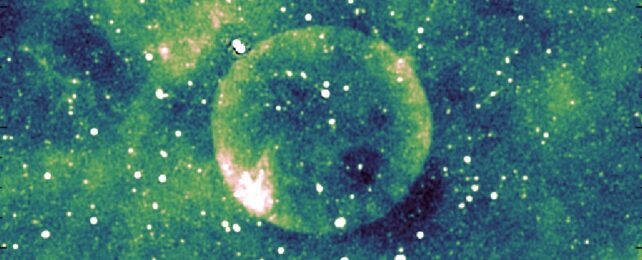Our Milky Way galaxy is home to some extremely weird things, but a new discovery has astronomers truly baffled.
In data collected by a powerful radio telescope, astronomers have found what appears to be a perfectly spherical bubble. We know more or less what it is – it's the ball of expanding material ejected by an exploding star, a supernova remnant – but how it came to be is more of a puzzle.
A large international team led by astrophysicist Miroslav Filipović of Western Sydney University in Australia has named the object Teleios, after the ancient Greek for "perfection". After an exhaustive review of the possibilities, the researchers conclude that we're going to need more information to understand how this object formed.

Their analysis has been submitted to the Publications of the Astronomical Society of Australia, and is available on preprint server arXiv.
The Australian Square Kilometre Array Pathfinder (ASKAP) has been uncovering a trove of peculiar circles of various kinds in the sky as part of its Evolutionary Map of the Universe (EMU) survey. Some of them at intergalactic distances have been a little difficult to figure out, like the famous Odd Radio Circles (ORCS).
Teleios, located within the Milky Way, has a different origin story than the ORCS found across the deep cosmos, but even though it is closer and therefore smaller, an inability to narrow down exactly how far away it is has proven a significant barrier to understanding its origin.
Filipović and his colleagues conducted a thorough analysis of the object, and found that it glows faintly only in radio wavelengths. The wavelength of its glow revealed it most likely to be the remnant of a Type Ia supernova – one of the brightest types of supernova in the Universe.
These supernovae occur when a white dwarf in a close binary orbit with a companion star slurps up so much material from said companion that it exceeds its mass limit and explodes.

So far, so straightforward. But working out distances to things in space is surprisingly quite difficult. The researchers were able to work out estimates for the distance to Teleios, but couldn't narrow it down beyond two options – around 7,175 light-years, and around 25,114 light-years.
As you can imagine, both of these distances would mean different things for the evolutionary history of Teleios. Because things look smaller the farther away they are, the two distances would yield vastly different sizes for the bubble. At the nearer distance, the supernova remnant would be 46 light-years across. At the greater distance, it would be 157 light-years across.
A supernova remnant often consists of an expanding cloud of material – so each of these sizes suggests a different age for the remnant. The closer distance suggests a younger supernova remnant that has had less time to grow, less than 1,000 years. At the greater distance, it would have to be more than 10,000 years old.
The problem with both of these scenarios is that evolutionary models of Type Ia supernovae predict there should also be X-rays. The lack of X-rays is a bit of a head-scratcher.
Another possibility is that Teleios is the remnant of a Type Iax supernova, a kind of Type Ia supernova that doesn't destroy the white dwarf entirely, but leaves behind a 'zombie' star remnant. This neatly fits Teleios's emission properties, but it would need to be a lot closer, around 3,262 light-years away.
This scenario would mean Teleios is a bit smaller, about 11 light-years across. There's even a star at that distance that could be a candidate for the zombie star… but none of the other independent measurements of the distance to Teleios find that it could be that close.

All these other issues make the unusual issue of the remnant's near-perfect symmetry fade into the background a little. Supernova remnants are almost always asymmetrical in some way. The explosion itself may be asymmetrical; the expanding material may push into interstellar gas or dust that was already hanging out nearby; and eventually, the shell will expand enough to start to fragment.
However, if the supernova is symmetrical and takes place in an empty enough region of space, it can expand symmetrically. It just hasn't yet reached the point of fragmentation. It's a rare sight, but not an impossible one. That makes Teleios pretty nifty, really.
We're just going to need to look at it a bit more to work out its story.
"We have made an exhaustive exploration of the possible evolutionary state of the supernova based on its surface brightness, apparent size and possible distances," the researchers write.
"All possible scenarios have their challenges, especially considering the lack of X-ray emission that is expected to be detectable given our evolutionary modelling. While we deem the Type Ia scenario the most likely, we note that no direct evidence is available to definitively confirm any scenario and new sensitive and high-resolution observations of this object are needed."
Their paper can be read on arXiv.
